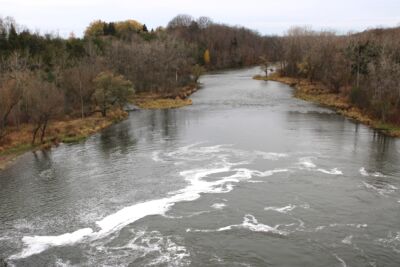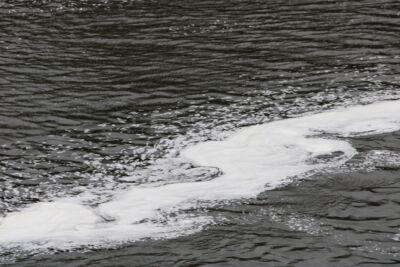Don’t Fear the Foam!
From time to time there is unsightly foam flowing down the river or accumulating along the shoreline in the Upper Thames River watershed. If you have every experienced this, you may have immediately thought this was some chemical flowing down the waterway. In a majority of situations, the foam is a natural phenomenon.

What causes foam?
Natural foam is composed of dissolved organic matter, specifically dissolved organic carbon that has come from decomposing plants. The natural die off of vegetation releases the organic materials plants are composed of, including oils, and the buildup of these compounds make it easier for foam to form and persist in the environment. Turbid areas in a stream can cause air and water to mix, creating bubbles or foam.
How do I identify foam?
Natural foam can look off-white to brown depending on the turbidity of the water and can have a fishy or earthy odour. Foam caused by a pollutant will usually be bright white, have a slimy feel and smell aromatic.
Does foam have value in an ecosystem?
A certain amount of organic matter is essential for healthy ecosystems due to the energy, food, and nutrient requirements of the ecosystem. Since foams are partially composed of dissolved organic carbon, it can be beneficial for aquatic ecosystems.
Where and when am I likely to see foam?
Foam can commonly be seen building up along shores of faster moving watercourses, downstream of riffles (a rocky or shallow part of a stream or river with rough water), or below structures such as weirs and dams. Wind action and boating can introduce air into the dissolved organic matter creating bubbles. After periods of drought when streams have been dry or stagnant and then experience a high flow, like after a rainfall, organic matter is washed out from deep pools creating conditions for foam to be created. Streams originating in wetlands or woody areas have high organic content, sometimes causing the water to look tea coloured, and these steams have a higher potential for foam formation due to enhanced levels organic matter being dissolved.

How to manage foam?
Naturally occurring foam does not require management and is part of a healthy ecosystem.
Synthetic or human made foam is a byproduct of chemical runoff or discharge. Sources can include household cleaning products, paint, pesticides used on lawns or fields, and motor oils running off impervious surfaces. Improved processing of wastewater and effective storm management has helped to reduce pollution related foam.
If you see foam that does not look right, please report it to Ministry of Environment Spills right away.
Contact: Craig Irwin, Water Quality Specialist

